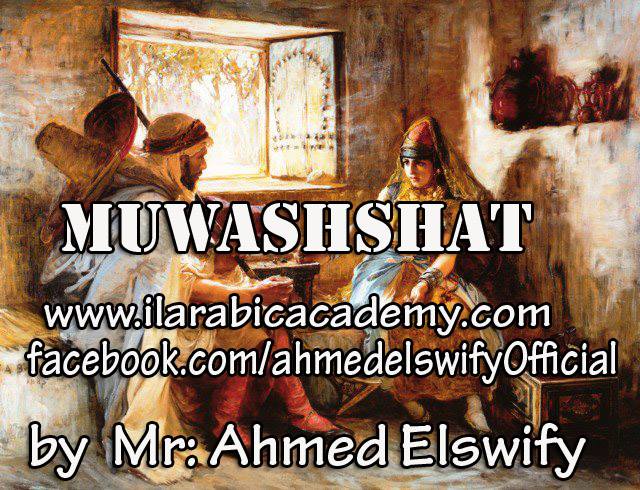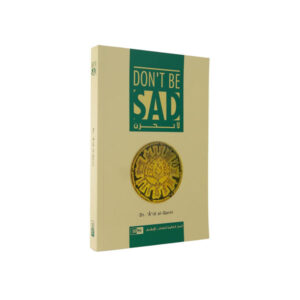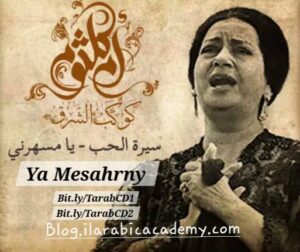WHAT IS MUWASHSHA ?!(موشح muwaššaḥ literally means “girdled” in Classical Arabic; plural muwāshshaḥāt موشحات or tawāshīḥ تواشيح

New services & Offers : Translate your Favorite Arabic songs , Texts, Documens, Online with cultural Notes
🆕️🆕️Make analysis of Your Arabic song and go over The Right pronunciation
Song translation with a bonus voice or Video recording with the transliteration & pronunciation through zoom or Whats App including cultural notes
Win A Free zoom personalized Analysis & translation workshop for your songs
Ilarabicacademy@gmail.com translate@ilarabicacademy.com
facebook.com/learnarabicsongs
Send us your song at :
📩 ilarabicacademy@gmail.com
we are pleased to release Our new THE BEST OF TARAB CD The Golden Era- Vol 1 > http://bit.ly/TarabCD1
Our new Shaabbi CD vol 2 < http://bit.ly/Shaabbi2
our Shaabbi hits CD vol 1 http://bit.ly/shabbihits1
Book your first Arabic class
Email : ilarabicacademy@gmail.com
Www.ilarabicacademy.com
facebook.com.com/AhmedelswifyOfficial
Www.ilarabicacademy.com
Www.bookstore.ilarabicacademy.com
an Arabic poetic genre in strophic form developed in Muslim Spain in the 11th and 12th centuries. From the 12th century onward, its use spread to North Africa and the Muslim Middle East.The muwashshah is both the product and a microcosm of the cultural conditions peculiar to al-Andalus. Its linguistic complexity reflects the fluid and diverse linguistic situation of the peninsula’s population. The muwashshah embodies the flexible and changing relation between the written language (classical Arabic), as well as between these languages and the oral forms (the Arabic spoken in Andalusia; Romance; and Mozarabic, the dialect formed from the mixing of Romance and Arabic). It reflects life in the court and on the streets; the sociocultural relations between various ethnic groups, and between the sexes; and even the tensions and rapprochement between secular and religious interests. . . .
THE FORMS The muwashshaḥ is written in Classical Arabic, and its subjects are those of Classical Arabic poetry—love, wine, court figures. It sharply differs in form, however, from classical poetry, in which each verse is divided into two metric halves and a single rhyme recurs at the end of each verse. The muwashshaḥ is usually divided into five strophes, or stanzas, each numbering four, five, or six lines. A master rhyme appears at the beginning of the poem and at the end of the strophes, somewhat like a refrain; it is interrupted by subordinate rhymes. A possible scheme is ABcdcdABefefABghghABijijABklklAB. The last AB, called kharjah, or markaz, is usually written in vernacular Arabic or in the Spanish Mozarabic dialect; it is normally rendered in the voice of a girl and expresses her longing for her absent lover. Such verses make it probable that the muwashshaḥ was influenced by some kind of European Romance oral poetry or song.
EXAMPLE ANDLUSIAN MUWASHSHA
لما بدا يتثنى Lamma bada Yatathannaلما بدا يتثنى Lamma bada YatathannaLamma bada yatathanna… Hubbi jamalu fatanna
Amru mâ bi-laHza asarna
Ghusnun thanâ Hina mal
Wa’adi wa ya Hirati
Man li raHimu shakwati… Fil-Hubbi min law’atiI
lla maliku l-jamal
Aman’ Aman’ Aman’ Aman
A master rhyme appears at the end of the strophes,”na-na & AL-AL & TI-TI ” somewhat like a refrain; it is interrupted by subordinate rhymes.
>>>>>>>>>>>>>>>>>>>>>>>>>>
TRANSLATION
When he was bending
when he was bending(this means he is dancing or doing something graceful)
My love, his beauty struck us
Something about it captivated us beauty
, as soon as he began to bend
My promise, oh my confusion, my promise, oh my confusion
Who could be the one to alleviate my sufferings in love,
from my torment, except the one of beauty
Oh mercy, oh mercy, oh mercy
Translation & Lesson Copyright @ Lighthouse Arabic Academy www.ilarabicacademy.com
lISTEN TO IT https://www.youtube.com/watch?v=CWRambAQfAA






More Stories
Essential & Survival Arabic Phrases – Part 4
Free Download: “Don’t Be Sad” – Arabic Psychological Healing for Depression & Anxiety Download Gratuito: “Não Fique Triste” – Cura Psicológica Árabe para Depressão e Ansiedade
Nova Tradução Completa e GRATUITA da Canção de Umm Kulthum – “Ya Msaharni”